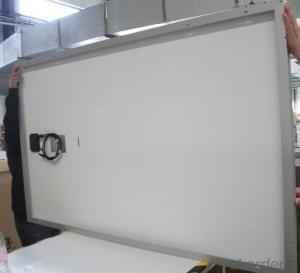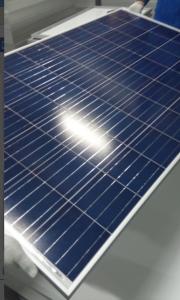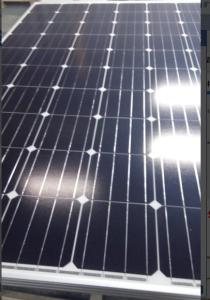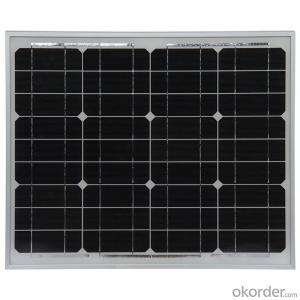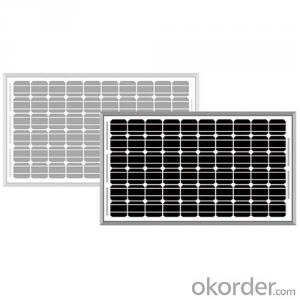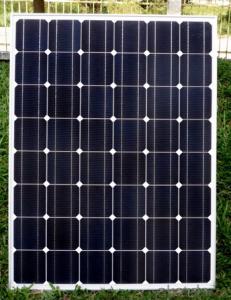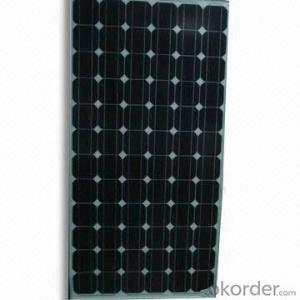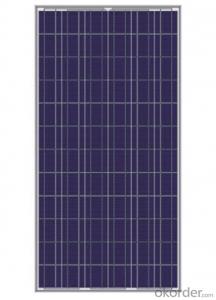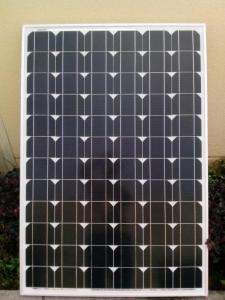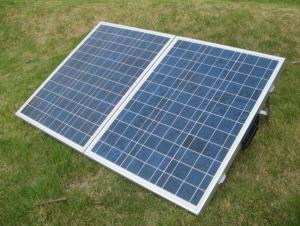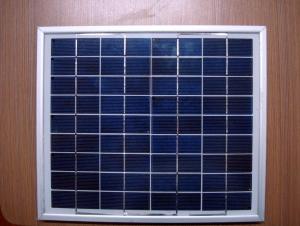Costco Portable Solar Panels - Monocrystal Photovoltaic (PV) Panel 300W
- Loading Port:
- Shekou
- Payment Terms:
- TT or LC
- Min Order Qty:
- 3 watt
- Supply Capability:
- 5000 watt/month
OKorder Service Pledge
OKorder Financial Service
You Might Also Like
What is the product?
Introduction of Solar Monocrystalline Series Panels
CNBM Solar PV Panel is designed for large electrical power requirements. It is the optimal choice for both on-grid and off-grid power systems. CNBM PV panel offers high performance of power per square foot of solar array. Monocrystalline silicon(c-Si): often made using the Czochralski process. Single-crystal wafer cells tend to be expensive, and because they are cut from cylindrical ingots, do not completely cover a square solar cell module without a substantial waste of refined silicon. Hence most c-Si panels have uncovered gaps at the four corners of the cells.
Characteristics of Solar Monocrystalline Series Panels
I Junction box: Multi function junction box with water proof.
II Long lifetime: ≥25 years; Less power decrease
III Good performance of preventing from atrocious weather such as wind and hails.
Advantages of Solar Monocrystalline Series Panels
• 12 years guarantee for workmanship
• Timeliness of delivery
CNBM International Corporation's products including Monocrystalline Solar Panel, Polycrystalline Solar Panel have received and enjoyed famous reputation in many countries and regions in the world .As a solar panel supplier in China, we strive to provide our customers with excellent service, superior products and unmatched value.
Temperature Coefficient of Cells
NOCT | 47℃±2℃ |
Temperature Coefficients of Isc (%/℃) | 0.064 |
Temperature Coefficients of Voc (%/℃) | -0.33 |
Temperature Coefficients of Pmp (%/℃) | -0.45 |
The dimension of the modules can be changed according to the demand of clients
Limits
Operating Temperature | –40 °C to +85°C |
Storage Temperature | –40 °C to +85°C |
Max System Voltage | 700V |
Guarantee Solar Monocrystalline Series Panels
Products Guarantee | 10 yrs free from defects in materials and workmanship |
Performance Guarantee | No less than 90% within 10yrs and no less than 80% within 25yrs |
Certificates | IEC, ISO, TUV, CE |
The Examination of Solar Monocrystalline Series Panels
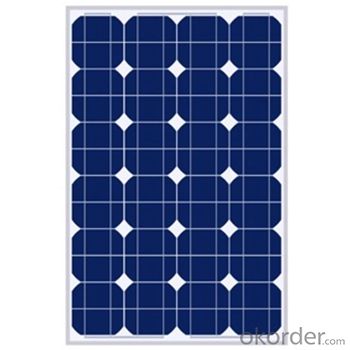

FAQ
We have organized several common questions for our clients,may help you sincerely:
1. Can you tell me the parameter of your solar panels?
We have different series of cells with different power output, both from c-si to a-si. Please take our specification sheet for your reference.
2. How do you pack your products?
We have rich experience on how to pack the panels to make sure the safety on shipment when it arrives at the destination.
3. Can you do FOB for us?
Yes, we can.
- Q: Can solar panels be installed on restaurants or food establishments?
- Yes, solar panels can be installed on restaurants or food establishments. In fact, many restaurants and food establishments are increasingly adopting solar energy systems to reduce their carbon footprint and energy costs. Solar panels can be installed on rooftops or other suitable areas to generate clean, renewable electricity for powering various operations within these establishments.
- Q: Can solar panels be installed on historical or protected buildings?
- Yes, solar panels can be installed on historical or protected buildings. However, there are certain considerations and guidelines that need to be followed to ensure that the installation does not compromise the architectural integrity or cultural significance of the building. Special care is taken to design and install solar panels in a way that minimizes visual impact and preserves the historical value of the structure. Additionally, obtaining necessary permissions and approvals from relevant authorities is crucial before proceeding with the installation.
- Q: Can solar panels be installed on a pergola or shade structure?
- Yes, solar panels can be installed on a pergola or shade structure. In fact, installing solar panels on a pergola or shade structure can provide both shade and renewable energy generation, making it a practical and efficient solution for maximizing space and reducing energy costs.
- Q: What Are Solar Panels Made Of?
- Create okorder /
- Q: Can solar panels be installed on churches or religious buildings?
- Yes, solar panels can be installed on churches or religious buildings. In fact, many religious institutions have embraced solar energy as a way to reduce their carbon footprint and demonstrate environmental stewardship. Installing solar panels on these buildings can not only help generate clean and sustainable energy but also serve as a symbol of the organization's commitment to promoting renewable energy and responsible resource management.
- Q: How do solar panels affect the property's community engagement?
- Solar panels can have a positive impact on a property's community engagement by promoting sustainable practices and sparking conversations about renewable energy. Solar panels serve as a visible symbol of a property's commitment to reducing carbon emissions and reliance on fossil fuels, which can inspire and encourage others in the community to adopt similar eco-friendly practices. Additionally, solar panels can be used as an educational tool, offering opportunities for community members to learn about solar energy and its benefits, fostering a sense of environmental awareness and collective action.
- Q: Most solar panels (the flat ones that go onto roofs of houses) reject electricity produced by the panels if they are too low in voltage. For example, on a cloudy day, although the panels may still get some sunlight to produce some electricity, it is rejected because its too low in voltage. So, does anyone have any ideas?
- On a day that's really dark, I don't think there is anything that can reasonably be done. The voltage is low because the power coming out of the panels is low. A circuit could step that voltage up, but could not increase the power. According to our user's manual, it takes 30 to 40 watts to run our inverter. So if the panels are putting out more than that, it's worth running the inverter. If not, then it's better to not even run it, so the inverter cuts out. A charge controller for a battery would have similar behavior if well-designed. Our array is large enough that during even relatively dark days, there is enough power so that the inverter won't cut out.
- Q: How Is heat From the Sun Transferred into Currents From solar Panels? (Explain Deeply Please)
- Solar panels are made of solar cells.Solar cells are mainly made of a semiconductor called silicon,when sunshine on it,solar energy is converted into electrical energy by photovoltaic.The energy knocks electrons loose, allowing them to flow freely.This flow of electrons is a current, this current, together with the cell's voltage (which is a result of its built-in electric field or fields), defines the power (or wattage) that the solar cell can produce.
- Q: i need technical and non technical details to generate MW power by solar panels
- First off, you should consider cost per kilowatt-hour (kWh) since kWh is energy whereas MW is power, and kWh is a common unit of energy used by power utilities. But first you would need to design the power capacity required, which as you state, is assumed to be MW. Average system costs = $95 per square foot Average solar panel output = 0.6 watts per square foot Average solar energy system costs = $8.95 per watt Form this information, the capital cost of installing MW = $8.95 /W * 0^6 W/MW = $9 million. The lifetime of a typical solar power system is probably about 20 years. Assuming a true MW peak output of the solar panel it would be anticipated that a daily average energy production would be peak output over about 3 hours per day, or 3 MWh of energy per day. Total production over a 20 year system life would be 3 MWh * 365 days/yr * 20 yr = 22 x 0^3 MWh So in terms of costs of capitalization of the system, the cost of Energy (/kWh) = $8.95 million / 22 x 0^3 MWh = $0.40 / kWh (approximately) This cost does not include maintenance, however, given the simplicity of these systems; other than periodic equipment replacement, which is covered by specifying a 20 year complete system replacement; other maintenance cost should be relatively low. The required surface area of solar panel = 0^6 W / 0.6 W/ft^2 = 94,340 ft^2 or a little over 2 acres of panel surface area. To be able to properly access and maintain the solar array, the minimum area required would likely be 5 to 0 acres.
- Q: Ok so my electric bill is through the roof because of the air conditioner (mini-split). Is there any kinds solar panel I can buy at a store and install it myself? Do I need any skills? Which brand? blah...blah...blah...
- Unless you live in an area with a very high UV index, like Las Vegas for example, solar panels are not cost-effective. You definatly should not attempt to install solar power yourself if you intend to power a residence with it (unless you live in a shack). A certified electrician is required in order to connect your equipment to your house's electrical system. It isnt just as simple as a few panels. You need a converter that turns the DC voltage generated into AC. You also need equipment to connect to the metering system for your house. If you want to see if it is cost effective, you will need your electric bills that show usage for a year and the price per kWH. There are a lot of websites that have calculators for solar power systems.
Send your message to us
Costco Portable Solar Panels - Monocrystal Photovoltaic (PV) Panel 300W
- Loading Port:
- Shekou
- Payment Terms:
- TT or LC
- Min Order Qty:
- 3 watt
- Supply Capability:
- 5000 watt/month
OKorder Service Pledge
OKorder Financial Service
Similar products
Hot products
Hot Searches
Related keywords

